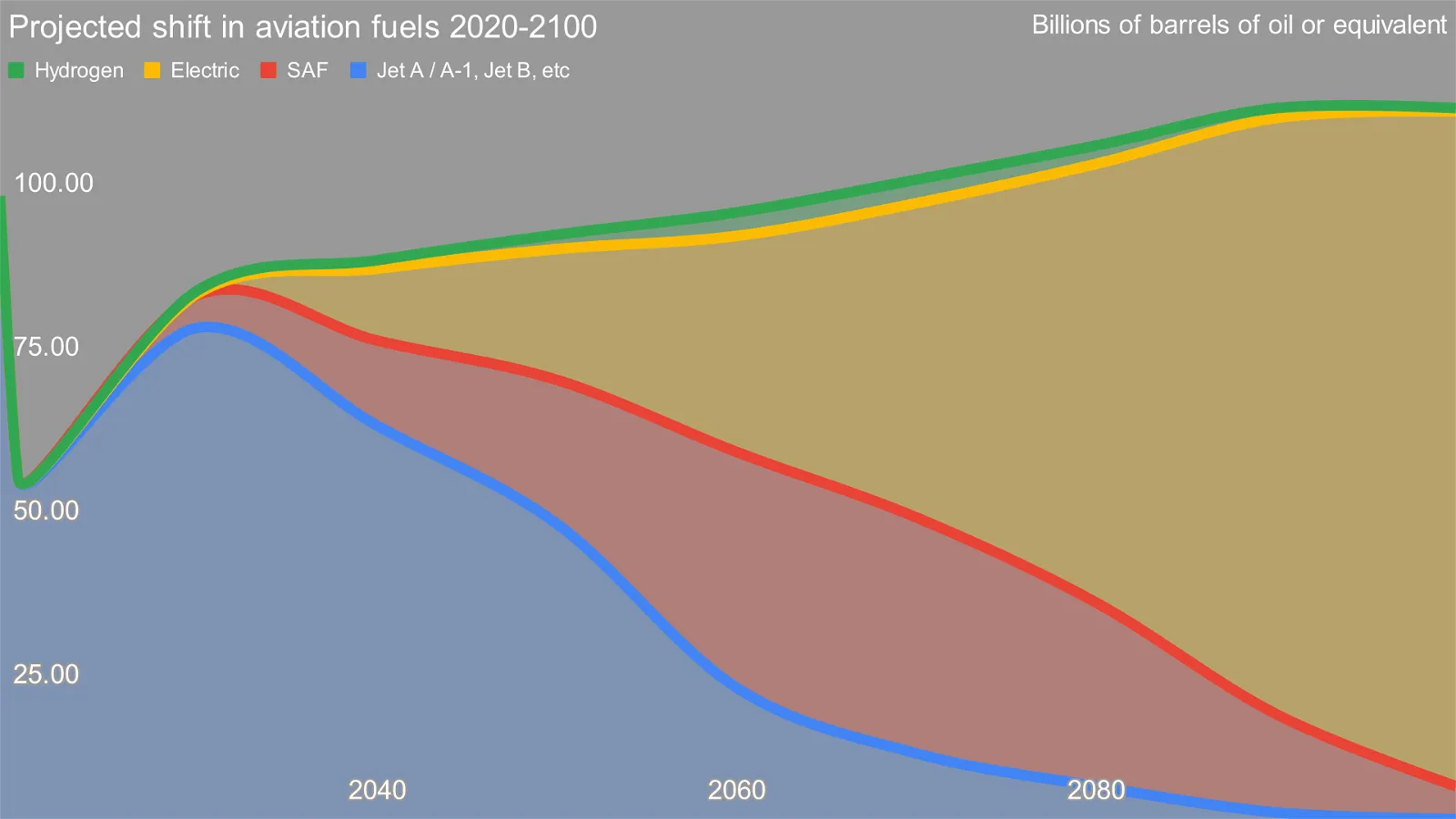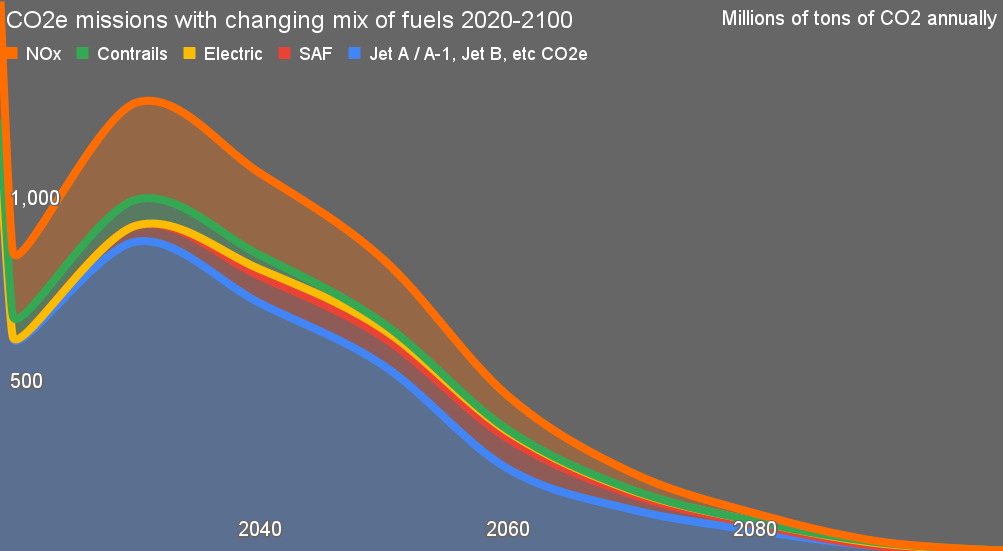How Aviation Will Decarbonize Decade By Decade Until 2100 (Part 2)
In part one of this multi-decade projection of aviation refueling, I put forward a scenario of the steady growth of battery electrification of aviation, and biofuels rising and then falling by the end of the century. In part two, the implications of this shift for the global warming impacts of aviation are explored. It’s good news, but not great news.

As a reminder, the projection sees a rebound of aviation to below 2019 levels, and then remaining flat instead of increasing. Electrification and biofuels only start to make a dent in the space in the second half of the 2030s, but then fossil fuel-derived kerosenes plummet quickly through 2060. The long tail of fossil fuels for aviation approaches zero by 2100 in this projection, but by the end of the century biofuels will mostly be a thing of the past as well. For those who consider this aggressive, 80 years ago few people owned cars, and almost no one had flown in an airplane.

But the question is global warming, and so on to the emissions equivalents.
Similarly to part 1, I’ll call out a set of obvious observations and some not so obvious ones.
First, aviation-related global warming emissions plummeted during COVID-19. Regardless of the measure, whether direct CO2, NOx or contrails, enormous numbers of flights didn’t occur for the past two years. It’s relatively insignificant compared to the history of CO2e emissions that will drive warming for the next century regardless of what else we do, but it’s still there.
Second, while aviation will not return to 2019 levels in my opinion, it will still rebound a fair amount over the next eight years, and emissions will rise as a result.
Third, it will likely take three decades before net emissions for aviation are back below 2020 levels. That’s a problem, but they’ll still be well below 2019 levels. That said, this projection suggests that while aviation is a hard target, more attention needs to be paid to it. Aviation emissions rising substantially this decade is not a climate solution.
Fourth, contrails and NOx CO2e ratios make it clear that biofuels are not a long-term solution. Both are significant warming side effects of burning fuels. The model includes operational changes that substantially reduce contrail formation and impacts, something that can be substantially done by just 500-meter changes in operating altitude. But burning any fuel in our atmosphere produces NOx with 265 times the global warming potential of CO2. Biofuels substantially reduce CO2 from the fuel and operational changes reduce CO2e from contrails, but NOx persists. They are much better than fossil fuels however. My understanding — correct me if I am wrong please — is that electric aviation should not create contrails.
Fifth, the initial CO2e of electricity is relatively high, but diminishes substantially through 2040 with grid decarbonization. As a result, CO2e savings from electrification grow per billion barrels of fuel equivalent with time.
Sixth, biofuels are also high in CO2e initially, but diminish through time. Agrigenetics related to nitrogen fixing at the roots of plants as per Pivot Bio, resultant reductions in fossil-fuel sourced ammonia fertilizers, precision agriculture lowering fertilizer use further, and low-tillage agriculture are going to radically reduce agriculture warming emissions in the coming decades. Every pound of fertilizer used today is equivalent to 9 pounds of CO2 between direct fossil fuel use and nitrous oxide formation after application. Diminishing fertilizer applied very precisely by electrified farming equipment brings agriculture close to zero emissions. I have conservatively not assumed soil carbon sequestration from farming in this analysis, but many studies project the potential for agriculture of all types to become carbon negative. This wouldn’t change the need to eliminate biofuels due to contrails and NOx by the way, so those who think biofuels have a future past 2100 can think again.
Seventh, emissions take until 2100 to approach zero. There will be a long tail of both fossil-fuel sourced kerosene and SAF biofuels into 2090 and 2100. Direct and indirect emissions are still substantial. Electricity is similarly going to have a long tail of lowering emissions. This is to be expected, and if not embraced, at least acknowledged. It’s going to take a long time to get rid of the long-tail CO2e emissions.
Eighth, hydrogen doesn’t show up on this chart because its excessive emissions are irrelevant in a world which doesn’t foolishly try to use it for fuel. We need to preserve green hydrogen for the 90 million tons of current uses that will still persist in 2100, per my projection.
The first obvious thing from the numerical representation is that 2020, per this imperfect assessment, saw only 55% of the aviation-related emissions as 2019. A glimmer of a silver lining on the dark cloud of COVID. Business has not stopped dead in its tracks, yet there were 45% less emissions from aviation.
The second obvious thing is how tiny the emissions of electric aviation are in direct fuel CO2e. For the first couple of decades the absolute numbers are tiny because the percentage of flights will be tiny. But into the second half of the century as battery-electric aviation eats close to the entire market share, its emissions drop radically. This is the value of a low-carbon ecosystem, where low-carbon generation feeds electrified energy services.
Third, the ratios for NOx and contrails are based on a couple of studies, but are imperfect. NOx has substantially varying impacts at different altitudes and differing atmospheric compositions, so this is necessarily a very coarse ratio. Contrails are also an approximation. They are problematic for turbofans at high altitudes, and very problematic for overnight turbofan high altitude flights, but operational changes decrease fuel efficiency, and so compromise CO2e savings in that regard. The ratios for NOx and contrails are hence made challenging by lower altitude flights with different fuels and mixes. Turbofans at altitude are the area of study for much of this, but the shift in flights to regional and lower altitude flights obfuscates the results. I would welcome pointers to better blended studies in this regard.
It’s worth calling out the contributions of SAF biofuels under this model, as they are considerable, if inadequate in and of themselves.

As Mark Z. Jacobson rightly points out, SAF biofuels are not a final solution due to contrails, NOx, and black carbon emissions that they still have. However, when the reduction over the coming decades of agricultural inputs brings the biofuel’s direct CO2 emissions down substantially, and when they are still at ~25% of today’s full lifecycle embodied CO2, the total annual savings with SAF biofuels is in the range of 400 mtons of CO2e annually. That’s material. And as can be seen, the long-tail without SAF biofuels is still 60 mtons annually.
Finally, I’ll remind readers who have made it this far that while my opinion is professional, informed, broad, and fairly deep, it is a still merely an opinion, and hence at the bottom of the ladder of evidence. And further, while I have a history with aviation and the transportation sector, and have been reviewing transportation related emissions and alternatives for a decade, my professional life is not solely devoted to this subject. The error bars on these projections are broad.
That said, the general outlines I think are correct. As I said in my assessment of hydrogen as an aviation fuel and the assessments of those who like it, they require an assumption of truly extraordinary advances that do not appear to be viable per the laws of physics. The economics of alternatives and operational requirements appear to make them so non-viable as to be easily dismissed.
To summarize, battery-electric aviation will be over 50% of flights by 2070, and approaching 100% by 2100. Biofuels will rise through 2060 and then start to fall again. This is an imperfect solution, but perfection is the enemy of the good enough. This projection sees total aviation-related warming at under a third of 2019 levels by 2060, and continuing to drop to approach zero by 2100. In 80 years, flygskam will be a thing of the past.
There’s at least one more thread to pull in this exploration of electrification of aviation: e-vtols vs. e-ctols. Cathie Wood’s Ark Investment Management is heavily into electric vertical takeoff and landing aircraft because it considers that new business models are being created. I think they are missing the bet. Stay tuned.
Additional references:
- https://www.baaqmd.gov/~/media/files/planning-and-research/research-and-modeling/saf-report-final-for-distribution-to-baaqmd-pdf.pdf?la=en
- https://onlinelibrary.wiley.com/doi/10.1002/bbb.2225
- https://www.energy.gov/eere/bioenergy/articles/sustainable-aviation-fuels-low-carbon-ethanol-production
- https://www.flyradius.com/bombardier-q400/fuel-burn-consumption
- https://www.convertunits.com/from/gigajoule/to/gallon+[U.S.]+of+kerosene+type+jet+fuelhttps://theicct.org/sites/default/files/publications/CO2-commercial-aviation-oct2020.pdf
Have a tip for CleanTechnica? Want to advertise? Want to suggest a guest for our CleanTech Talk podcast? Contact us here.
Latest CleanTechnica.TV Video

CleanTechnica uses affiliate links. See our policy here.

